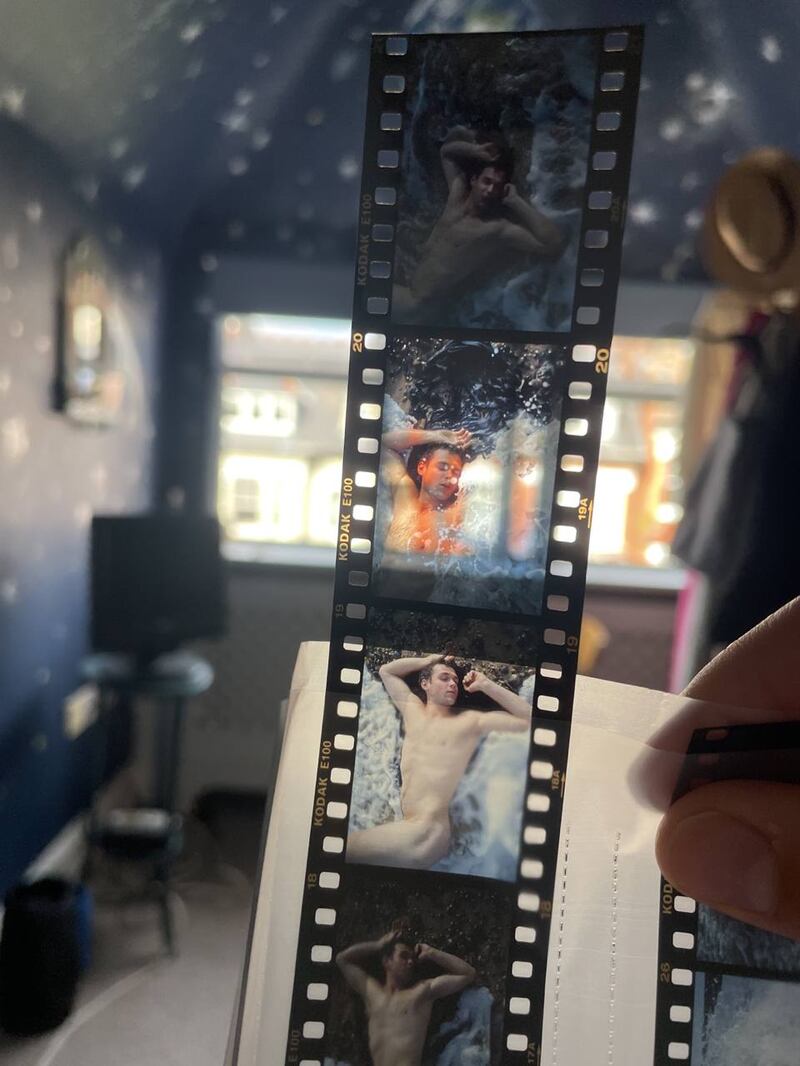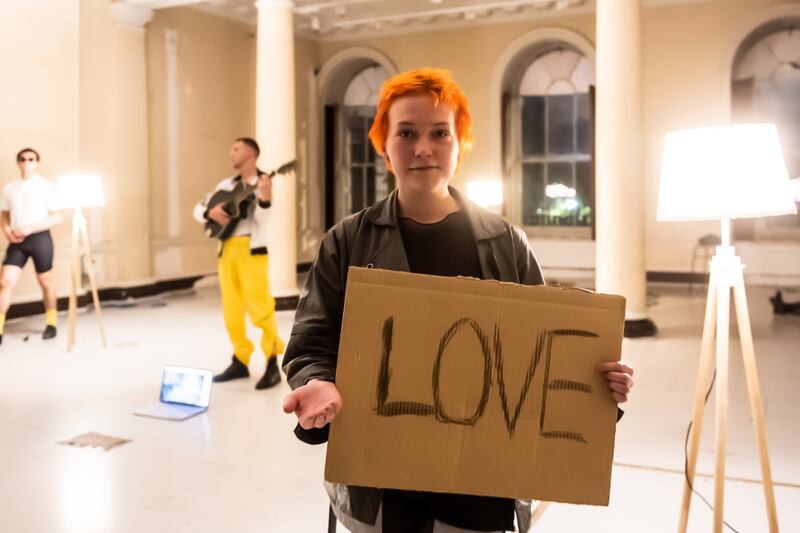When Russia invaded Ukraine, in February 2022, the members of Kyiv’s Hooligan Art Community found themselves dispersed. Actor Mirra Zhuchkova and designer Natalka Perchyshyna were evacuated, making their way to Germany, where they secured an artists’ residency at WUK Theatre Halle, while its male members, Sam Kyslyi and Danylo Shramenko, were unable to leave the country as part of Volodymyr Zelenskiy’s early-war directive. However, the artists, who have been performing together since 2019, were determined to keep working as a group, “to be united despite space and distance”, as Kyslyi explains. It was important for the group, he says, “to make art [as a way] to feel alive again. This creativity saved me and Danylo from this complete position of being lost, floating, waiting to know if we will be called to the army or not.”
[ Only Ukraine victory will guarantee European values, Zelenskiy tells MEPsOpens in new window ]
[ ‘Wrong side of history’: Ukraine athletes accuse IOC of ‘kowtowing’ to RussiaOpens in new window ]
Zhuchkova was able to work in Germany and set about creating a new piece of work that would respond to the immediate circumstances of war. The resulting performance, Hooligan: Bizhenka, premiered in May. Focusing on the experience of female refugees, it was performed in Halle by a cast of female professional Ukrainian artists, including Zhuchkova, and a community chorus of displaced Ukrainian citizens. Back in Kyiv, meanwhile, Kyslyi and Shramenko were experimenting with their performance practice under the limited conditions of the bunker they were sheltering in. They were making videos on their phones, and with cameras, sharing the recorded scenes with their creative collaborators in Germany. The films were eventually screened on TVs as part of Hooligan: Bizhenka: a vivid documentary capture to counterpoint the war-themed live work.
![Bunker Cabaret: 'We wanted to communicate with people, to show them what was happening in Ukraine and what it [was like] for people living in the war.'](https://www.irishtimes.com/resizer/v2/LPMMU2KDYRAWFKUEXZICYNMLYE.jpg?auth=1710c9656948dc2134fd96e630b33661408c8304e58855ea9beff730b93a6a64&width=800&height=534)
If Hooligan’s first impulse for continuing with their creative practice was “finding a way to unite with each other” Kyslyi says that himself and Shramenko realised as they were performing in the bunker that “we were speaking about the things we wanted to communicate with people, to show them what was happening in Ukraine and what it [was like] for people living in the war.” Shramenko says they were looking first to “make a show for a European audience. We wanted to communicate with [a] western audience because at that time support from European governments wasn’t so big and we wanted to communicate on this field to say we need support, to say who we are, what culture we have, what we are fighting for, and build bridges between [our] cultures.”
Kyslyi and Shramenko were eventually able to leave Ukraine and, in August, the company’s founding artists were reunited in London. Kyslyi and Shramenko’s experience in Kyiv became the bedrock of Bunker Cabaret, a chilling evocation of wartime reality and a stirring call for hope, which tours to Waterford’s Theatre Royal later this month.
Actor Armie Hammer resurfaces as host of celebrity podcast
Heart-stopping Halloween terror: 13 of cinema’s greatest jump scares
Doctor Odyssey’s core message: just imagine Pacey from Dawson’s Creek holding you tight and saying, ‘Shhh, it’s okay’
Conor Niland’s The Racket nominated for William Hill Sports Book of the Year

Kyslyi, Shramenko and Zhuchkova are speaking to me by Zoom from Leipzig, where the trio are currently in residence at the Schaubühne Lindenfels, performing Bunker Cabaret for an audience of locals and refugees. Although conceived as an environmental response to bunker life, the company’s long-standing interest in site-specific theatre allowed them to imagine its performance in a variety of different contexts. As Shramenko explains “before the war we were usually working site-specifically, always trying to adapt our show to some space. We would be interested in the history of the space – what was here before – to find a source of connection.” Kyslyi continues: “How to take the bunker cabaret from one space to another is our inspiration in this piece. It helps us to find where we are as performers, what we are playing for. [Adapting to a new site] is our tool to get to our inner visions of what is here with us now.”
[ Should Russian art be boycotted for the duration of the war in Ukraine?Opens in new window ]
Bunker Cabaret premiered in September 2022 at the Lancaster Rooms in London’s Somerset House, as ostentatious a setting as you could imagine for a piece set in a safe-house underground, whose textual fabric counterpoints themes of love and totalitarianism, and the personal conflicts of making political art in a time of war. Kyslyi describes the Lancaster Rooms’ “long, huge windows” from which you could see “the river and buses going by. It was a beautiful space and this was the challenge we found so inspiring: how to bring the feeling of a bunker into this kind of space. [The Bunker Cabaret] is not about putting people in a place,” he elaborates, “so they think they are in a bunker. It is about the exchange of experience and feelings” of bunker life.

Because of its site-responsive nature, the performance, Zhuchkova says, is evolving each time they perform it. After Leipzig, Hooligan Art Community will move on to Berlin for a two-week residence. Before travelling to Ireland, the company will return to London for performances that coincide with the first anniversary of the war. The artists are resigned for the moment to this itinerant way of life, depending on arts centres across Europe to sponsor them as they highlight the continued plight of their country. Kyslyi admits it can be exhausting: “We are always on the road. We spend a couple of days adapting the play, showing it and then we are on the road again. But the possibility of meeting communities during this time, it’s incredible and it is inspiring how people are supporting us and how interested people are in what we say. From our name you see that we are interested in communities: we like to meet people and make that exchange of energies.”
[ How the war in Ukraine met the war on wokeOpens in new window ]
When they arrive in Waterford, meanwhile, Hooligan Art Community will be hosted by the Theatre Royal, with support from the Arts Council of Ireland, Waterford City and County Councils and a variety of local business and individuals, for a two-night run of Bunker Cabaret in the Large Room, City Hall. Mary Boland of Waterford’s Theatre Royal has been in charge of organising their visit, and she says that originally she had hoped to use the theatre’s foyer for performances. “We are lucky to have this beautiful vestibule that is almost 230 years old,” she says, “and it was very like the spaces we saw that Hooligan had performed in before.” When it became unavailable, Boland queried the availability of the Large Room in City Hall, which, she explains, was formerly the building’s assembly rooms “where gentry used to gather for performances 250 years ago. It is a beautiful, ceremonial room with large windows and fits in very well with what [the company] need, but especially because of that old connection [with performance] we felt it would be very poignant” for Bunker Cabaret to be staged there.

City Hall is also connected to the city centre and the other venues where Hooligan Art Community’s work will be hosted. Alongside their live performance of Bunker Cabaret, a series of short films will be showcased at the Garter Lane Theatre, with an outreach event to connect the artists with the local community and with other arts organisations in Ireland, which might be in a position to offer them support for their work over the next few months. As Boland concludes, “It is so important that Hooligan’s artists get to tell their stories to an Irish audience. Their theatre and their vision for their culture needs recognition and a platform on the international stage now more than ever.”
Hooligan Art Community’s Bunker Cabaret will be presented by Theatre Royal Waterford at the Large Room, Waterford City Hall, on Thursday, March 2nd, and Friday, March 3rd






